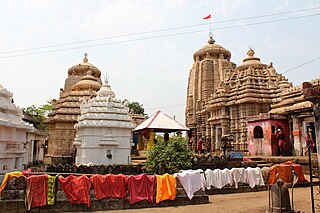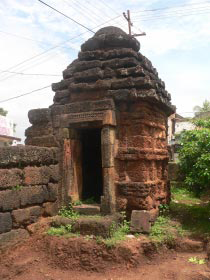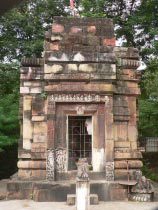
Kedareswar Temple, one of the eight Astasambhu Temples, is near the Mukteswar Temple, in Bhubaneswar, Odisha. The presiding deity is Shiva, referred to locally by the name ‘Kedareshwar’. It is in the precinct of Kedara-Gouri on the right side of the road leading to Puri from Bhubaneswar and at a distance of 40 metres south of Muktesvara. It is one of the ten monuments within the precinct. It is the main temple of the complex. The temple is facing south and the enshrined deity is a circular yonipitha made of sandstone. The linga at the centre is missing. The sanctum is 2.5 square meters which is 0.8 meters below the present ground. It stands near the yard of the Mukteswar Temple.
Jalesvara Siva Temple Precinct is a Hindu Temple dedicated to Shiva situated on the southern outskirt of the village Kalarahanga at a distance of 2.00 km from Patia and 6.00 km south of Chudangagada in the northern outskirt of Bhubaneswar, Odisha, India. The presiding deity is a Siva-lingam within a circular yonipitha inside the sanctum, which is 1.15 meters below the chandrasila. The sanctum measures 2.00 square meters.
Kalabhairavi Temple is located at Bhubaneswar of Odisha, India within the Jaleswar Siva Temple Precinct, Kalarahanga. The enshrined deity is a four armed Chamunda sitting over a dead body. The deity holds a khatuanga in her upper right hand, a snake in upper left hand, a severed head in lower left hand and the lower right hand is broken. The deity is crowned with jatamukuta and wearing a garland of skull. The whole image rests over a pedestal measuring 0.50 metres in height.

The Kapilesvara temple is a Hindu temple dedicated to Shiva located in the south western outskirt of the village Kapilesvara, Old Town, Bhubaneswar, Odisha, India. It is located at the end of Kapilesvara road leading from Lingaraj temple to Kapilesvara Village. The presiding deity is a Siva-lingam at the center of a circular yonipitha inside the sanctum. It is a living temple, facing towards east and maintained by Kapilesvara Temple Trust Board. The temple is situated within the precinct along with 33 other monuments. The precinct is located on the northern embankment of Manikarnika tank over an area of 44.00 square metres.
Nilakanthesvara Shiva Temple is a temple in Orissa, India, located on the western embankment of the Bindusagar tank. It is situated on the left side of the lane branching from the road leading from Kedar Gouri chowk to the Vaitaḷa deuḷa in Bhubaneswar, the capital state of Orissa. The temple faces east. The temple's enshrining deity is a circular yoni pitha with a chlorite Siva lingam. The temple is made out of sandstone. The present temple is a recent construction over the remains of an earlier one. The building material is old but the entire structure now has cement plaster and an enamel point.

Champakeswara Shiva Temple is located Ambika Sahi in the Old Town area of Bhubaneswar in Odisha, India. It is 157 metres west of Parasuramesvara on the right side of the Kotitirthesvara lane leading to Bindu sagara. It is a laterite temple. Local people believe that the enshrined Siva lingam is patalaphuta and the precinct is the abode of nagas after whom the deity is named as Champakesvara. The local people also believe that the temple precinct which is a den for the snakes do not harm any body.

Purvesvara Siva Temple is located in Kancha Sahi, in the Old Town of Bhubaneswar, Orissa, India. It was built in 13th century AD. It is a living temple and now under the care of Purvesvara Temple Development Association.
Suresvara Mahadeva temple, also known as Byamokesvara temple, is located in the Tala bazaar market complex, Old Town of Bhubaneswar, the capital of the state of Orissa, India. The temple is located in front of the Lingaraj Temple across the road in the left side of the eastern gateway at a distance of 10.00 m. The temple faces towards the west. It is a living temple and the enshrined deity is a Siva lingam with a circular yonipitha at the centre of the sanctum. At present the sanctum is 1.50 m below the present road level. It is a recently recovered temple that had been buried. It was built in 10th century AD. The temple is maintained by the local shopkeepers.
Markandesvara Siva Temple was constructed by Kesaris to commemorate the visit of sage Markandeya, same as the Samesvara Siva temple. It is an abandoned temple and is facing towards the east. However at the center of the sanctum there is a Siva-lingam with the circular Yoni pitha. The temple is totally covered with wild vegetations.
Nilakantha Siva temple is located in the Kharakhia Baidyanatha temple precinct, Kharakhia Vaidyanath Sahi, Old Town, Bhubaneswar. One can approach to this site on the left side of the Vaidyanath road leading from Lingaraja temple to Kapilesvara. This is a living temple and is facing towards the west. The enshrining deity of this temple is a Siva lingam within a circular yoni pitha at the centre of the sanctum sanatorium. The sanctum is 0.77 metres below the chandrasila.
The Somesvara Siva temple is located in the Kharakhia Baidyanath temple precinct in Kharakhia Vaidyanath Sahi, Old Town, of Bhubaneswar. It is located approximately 300 metres south of Lingaraja temple. Visitors may approach the site on the left side of Baidyanath Road leading from Lingaraja temple to Kapilesvar. It is a living temple and faces towards the west. The enshrined deity of this temple is a Siva lingam within a circular yonipitha at the center of the sanctuary located 0.93 metres below the chandrasila. The temple is under the care and maintenance of Babulal Makaddam Badu Mohapatra, the chief priest of the temple, on whose private land the temple stands.

Pabaneswara Shiva temple is situated in Bhubaneswar, Orissa, India, at a distance of 100.00 metres east of Parashurameshvara Temple on the left side of the road leading to Kedara Gauri temple. The temple has a vimana with a renovated porch, facing towards east. The presiding deity is a Shiva linga within a circular yonipitha inside the sanctum. It is a living temple. The temple is surrounded by private residential buildings and market complex on three sides and the road on the south. The temple was rebuilt or renovated sometimes back as it appears from the second phase of building from above the pabhaga.
Ladu Baba Temple is a temple in Bhubaneswar, Odisha, India. It was built in the 13th century AD and was formerly known as Kainchhi Temple.

The Tirthesvara Siva temple is a Hindu template located in Bhubaneswar, the capital of Odisha, India.

Uttaresvara Siva Temple is a 12th-century Hindu temple dedicated to Lord Siva located in Bhubaneswar, Odisha, India.

Mangalesvara Siva Temple is a Hindu temple located in Bhubaneswar, Orissa, India. It is located at Lat- 20◦ 14’ 38" N., Long- 85◦ 50’ 38" E., and at an elevation of 45 ft.

Papanasini Siva Temple is an abandoned Hindu temple located in Bhubaneswar, Orissa, India.
Present Name- Lokanath Siva Temple Address: Tala Bazar Road, Old Town, Bhubaneswar, Odisha, India.

The Talesvara Siva temple is a Hindu temple in Bhubaneswar, Odisha, India.
Visvanatha Siva Temple is a Hindu temple dedicated to Visvanatha and is one of the temples of Bhubaneswar, a revered pilgrimage center and the capital of the state of Orissa, India. It is a living temple, facing west, situated on the road from Lingaraja Temple to Mausima Temple. The presiding deity is a Siva lingam with a circular yoni installed inside the sanctum that was brought from Kasi. The temple was built in the 19th century and is of modern construction.












